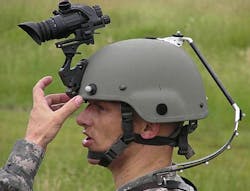Army eyes exoskeleton technology to reduce wear and tear on soldiers from wearing helmets
ADELPHI, Md., 8 Aug. 2013. Experts at the U.S. Army Research Laboratory in Adelphi, Md., have developed a prototype exoskeleton device to give gunners, patrol personnel, cooks, medics, and other soldiers who wear helmets for long periods of time much-needed head and neck relief, Army officials say.
Army researchers are demonstrated the Vertical Load Offset System (VLOS) robotic exoskeletal device that displaces the static load of the helmet onto the shoulders to reduce strain overall on a soldier's head and neck.
In tests some soldiers reported the sensation of lighter head-borne weight and more helmet stability, which is a major step forward -- especially with the dynamic movement of the head in combination with helmets loaded with equipment such as night-vision devices, batteries and other equipment -- Army researchers say.
Soldiers at Aberdeen Proving Ground, Md., tested the VLOS exoskeletal device during a weeklong human-factors evaluation earlier this summer on the soldier performance equipment advanced research (SPEAR) obstacle course and at the SPEAR Biomechanics Laboratory.
VLOS could "serve as a technology solution that makes helmets with more ballistic coverage and head-borne electronic hardware more tolerable," says Shawn Walsh, principal investigator for VLOS concept development.
"This research is allowing us to dissolve the boundary between head protection and torso body armor, which historically have been discrete, disconnected systems," Walsh says.
"VLOS has enabled us to move into exploring new modes of soldier protection research; it could represent a totally new piece of equipment not found in any soldier ensemble issued to date," Walsh says.
Early requirements suggested that the device should be lightweight, minimally intrusive, and a retrofit to current helmet and body armor systems. The field study looked at ways to get soldiers to actually wear such a device.
In tests soldiers crossed the 1.5-mile obstacle course, ran a series of 20-meter sprints, crawled for 10 meters, climbed a ladder, and handled their weapons.
"The device has been designed to offset the load, while still providing full unencumbered motion to the head and neck, enabling the soldier to have the same level of maneuverability, while easing the strain to the neck due to the weight of the personal protective equipment," says Bill Harper, a research psychologist with the Army Research Lab's Human Research and Engineering Directorate.
"This concept may enable higher levels of protection through use of nonconventional materials for head protection by reducing the load on the head and neck and transferring this load to the shoulders," says Harper, the principal investigator of the evaluation.
The Army Research Lab teamed with Creative Engineering LLC in Bronxville, N.Y., on the VLOS exoskeletal helmet project. to "solve this impossible problem" by combining innovative design concepts and engineering rigor to create VLOS from CNC machined aluminum parts with fiberglass flex arms and custom molded carbon fiber.
Funding from the U.S. Army Natick soldier Systems Center in Natick, Mass. helped support the VLOS development.
For more information contact the Army Research Lab online at www.arl.army.mil, the Army Natick soldier Systems Center at www.army.mil/info/organization/natick, or Creative Engineering at www.creativeengineering.com.
